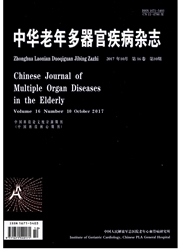

 中文摘要:
中文摘要:
目的:分析阵发性心房颤动(房颤)患者左心房低电压与肺静脉电隔离术后复发的关系。方法连续168例阵发性房颤患者[女性76例,年龄(62±11岁)],窦性心律下行左心房高密度(≥100点)标测,之后行肺静脉电隔离术治疗,在肺静脉隔离20min后给予异丙肾上腺素+腺苷三磷酸(0.2mg/kg),观察肺静脉传导恢复与否以及是否存在肺静脉外局灶触发的房颤,并对传导恢复的肺静脉以及肺静脉外局灶再次消融,直至激发试验阴性。本组患者均不进行基质改良。低电压的定义为CARTO消融导管记录的心肌局部双极电图振幅<0.5mV。结果42例(25.0%)患者的左心房存在低电压区,主要位于左心房前壁(22例,52.4%),与女性和左房直径增大相关。所有患者均完成肺静脉电隔离。随访(23±12)个月,35例患者复发房性快速心律失常,其中左房低电压者14例(14/42,33.3%),非低电压者21例(21/126,16.7%,P=0.028)。结论阵发性房颤患者左心房存在低电压区增加肺静脉电隔离术后的复发率,其形成可能与性别和左房直径有关。
 英文摘要:
英文摘要:
Objective To investigate the correlation of left atrial low-voltage zones (LVZs) with atrial fibrillation (AF) recurrence after pulmonary vein (PV) antrum isolation (PVAI) in paroxysmal AF patients. Methods A total of 168 consecutive patients [92 males and 76 females, with age of (62±11) years] who underwent PVAI for treating AF in our department were enrolled in this study. High density (≥100 points) left atrial voltage maps were reconstructed during sinus rhythm using CARTO 3 system. LVZs were defined as areas with bipolar peak-to-peak voltage amplitudes 〈0.5mV. In 20min after PVAI, all patients were given intravenous injection of isoproterenol and adenosine triphosphate (ATP, 0.2 mg/kg) in an attempt to unmask PV reconnection and AF triggered by non-PV foci. If PV reconnection and non-PV foci were elicited, additional ablation was carried out till provocative test became negative. Results Voltage maps revealed LVZs in 42 patients (25%) but not in the other 126 patients (75%). The LVZs were distributed on the anterior wall in 22 patients (22/42, 52.4%), and correlated with female and larger left atrial diameter. PVAI was completed in all these patients. During (23±12) months of follow-up, 14 patients (14/42, 33.3%) with LVZs and 21 (21/126, 16.7%) without LVZs had AF recurrences (P=0.028). Conclusion LVZs in paroxysmal AF patients increase the recurrence after PVAI, which might be correlated with gender and left artial diameter.
 同期刊论文项目
同期刊论文项目
 同项目期刊论文
同项目期刊论文
 期刊信息
期刊信息
